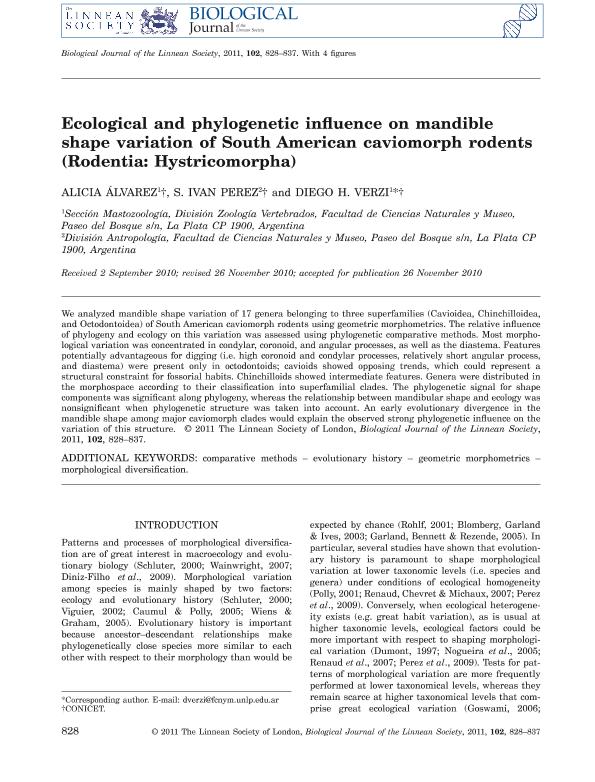Artículo
Ecological and phylogenetic influence on mandible shape variation of South American caviomorph rodents (Rodentia: Hystricomorpha)
Fecha de publicación:
04/2011
Editorial:
Oxford University Press
Revista:
Biological Journal of The Linnean Society
ISSN:
0024-4066
Idioma:
Inglés
Tipo de recurso:
Artículo publicado
Clasificación temática:
Resumen
We analyzed mandible shape variation of 17 genera belonging to three superfamilies (Cavioidea, Chinchilloidea, and Octodontoidea) of South American caviomorph rodents using geometric morphometrics. The relative influence of phylogeny and ecology on this variation was assessed using phylogenetic comparative methods. Most morphological variation was concentrated in condylar, coronoid, and angular processes, as well as the diastema. Features potentially advantageous for digging (i.e. high coronoid and condylar processes, relatively short angular process, and diastema) were present only in octodontoids; cavioids showed opposing trends, which could represent a structural constraint for fossorial habits. Chinchilloids showed intermediate features. Genera were distributed in the morphospace according to their classification into superfamilial clades. The phylogenetic signal for shape components was significant along phylogeny, whereas the relationship between mandibular shape and ecology was nonsignificant when phylogenetic structure was taken into account. An early evolutionary divergence in the mandible shape among major caviomorph clades would explain the observed strong phylogenetic influence on the variation of this structure.
Archivos asociados
Licencia
Identificadores
Colecciones
Articulos(CCT - LA PLATA)
Articulos de CTRO.CIENTIFICO TECNOL.CONICET - LA PLATA
Articulos de CTRO.CIENTIFICO TECNOL.CONICET - LA PLATA
Articulos(MACNBR)
Articulos de MUSEO ARG.DE CS.NAT "BERNARDINO RIVADAVIA"
Articulos de MUSEO ARG.DE CS.NAT "BERNARDINO RIVADAVIA"
Citación
Alvarez, Alicia; Perez, Sergio Ivan; Verzi, Diego Hector; Ecological and phylogenetic influence on mandible shape variation of South American caviomorph rodents (Rodentia: Hystricomorpha); Oxford University Press; Biological Journal of The Linnean Society; 102; 4; 4-2011; 828-837
Compartir
Altmétricas




